Several years ago, my wife and I were driving to Washington DC and saw scores of bucket trucks heading south on I-95. A category 4 hurricane was ravaging the Florida coast at that very moment, and thousands of contractors with their drain cleaning tools and machines were heading south towards the affected areas, ready to Read more
Just the Tip

Several years ago, my wife and I were driving to Washington DC and saw scores of bucket trucks heading south on I-95. A category 4 hurricane was ravaging the Florida coast at that very moment, and thousands of contractors with their drain cleaning tools and machines were heading south towards the affected areas, ready to participate in the clean-up and recovery. Over the past several decades, that same scenario has played out in a similar fashion, more times than we wish to remember, and if the weather channel is correct in its predictions, it will not be slowing down anytime soon.
Disaster cleanup and recovery has become a specialty within the trades. Contractors trained in the use of bucket trucks (often referred to as cherry pickers), chainsaws, backhoes, pressure washers, and drain cleaning machines have begun arriving at disaster sites even before the local population emerges from their shelters. The reason for this, of course, is money. It is not unusual for insurance companies, along with local state and federal governments, to pour billions of dollars into recovery efforts after a disaster. Just this year, there have already been a total of eight weather events in the US that created over a Billion dollars in damage. After Hurricane Katrina in 2005, the federal government alone spent more than 120 billion in emergency relief. With money like that making its way to the ground, contractors all over the country have taken notice.

Most of the activity around disaster cleanup and recovery is straightforward and predictable. After a hurricane, tornado, or flood, there is major damage to buildings and infrastructure that must first be demolished and then rebuilt. Roofs, utility wires, and poles must be repaired and replaced. Downed trees must be cut up and removed. And perhaps most importantly, potable water service and sewage lines must be brought back into operation.
Restoring normal plumbing after a flood, hurricane, or tornado can be more difficult than expected because of the large amount of mud and debris that finds its way into the sanitary sewer system. We’ve all seen contractors and property owners pressure washing mud and debris off affected areas after a disaster, but we seldom think about where all that muddy water is going. Most of it goes down an existing drain. When sewer and drain systems are built, plumbers make assumptions about the volume of liquid the pipes will be required to transport. The most popular rule of thumb that I’ve heard is that the main drain emptying wastewater from a building should be able to accommodate all the possible water that could exit the building at one time. In other words, if you turned on all the water faucets and flushed all the toilets at once, the main drain should only fill up to two thirds of its diameter. Fortunately, plumbers routinely over engineer sewage systems to avoid wastewater spillage. Since this logic applies to all drains, from the smallest to the largest, there usually isn’t much danger that workers with pressure washers will overwhelm the sewage system capacity to handle liquid. However, flood waters are another story, and it is not uncommon for sewage systems to suffer considerable damage during a natural disaster. This damage can open the door for debris clogs and root incursions that can render the system inoperable.
Another huge problem is the enormous quantity of mud that enters the waste removal system immediately after a flood. Some of the mud enters the system during the flood, and almost as much is washed down the nearest drain by the cleanup crew. If all the soil that is suspended in the mud reached the sewage treatment plant, that would be a problem in itself…but of course, it doesn’t. As the muddy water travels down the drainpipe, the soil slowly falls out of suspension and begins to fill up all the available space. Eventually, it can choke the drain completely so that liquids cannot pass, or at the very least give invading roots all the food and water they need to thrive. In either case, the drainpipe will be out of commission.
At that point, the services of a plumber or professional drain cleaner will be needed. Local drain cleaning activity skyrockets after a natural disaster, as does the need for our drain cleaning machines. Not just snake style machines, but high-pressure water jetters, inspection and location equipment, and flexible shaft devices. All these machines, from brands like General Pipe Cleaners, have slightly different functions and benefits, and all will be crucial tools in the affected area’s recovery. In fact, plumbers would argue that repairing the drain system is the most important piece of the disaster cleanup process.
As our ancestors discovered thousands of years ago, human beings cannot live in close proximity without fresh water and waste disposal. Both are necessary, and to a large extent, a plumber’s most important job is to keep fresh water and waste separated from each other. After a natural disaster, one of FEMAs main concerns is the possibility of cholera, because of the presence of human waste in flood waters and debris. Until the drains are open and functional, people cannot move back into their homes, and the area cannot be considered safe. Life as we know it cannot return to normal without a functional sewage system, and this system is maintained by drain cleaning equipment from reputable manufacturers. In the aftermath of a natural disaster, we notice increased demand for all types of drain cleaning machines. Cable or snake style machines are used to cut through hard blockages like debris, roots, and hardened mud. High-pressure water jetters can initially be used to dissolve and remove mud blockages, and then to clean the inside of the pipes to facilitate inspection by pipe inspection camera systems. These same pipe inspection and location systems can pinpoint damage to the pipes, where they’re crushed or displaced, so that repair work can commence. Flexible shaft machines are a new and versatile addition to the plumber’s toolbox and will likely be very useful in many disaster recovery operations.

Several machines, like those provided by General Pipe Cleaners, can be used in the same drain cleaning job. A cable machine or snake style machine is often employed first to create an initial opening in a drain clog caused by mud or debris. Following this, high-pressure jetters and flexible shaft devices come into play to comprehensively clear the obstruction. Camera systems, another vital drain cleaning tool, are often introduced into the drain line in conjunction with jetters or flexible shaft machines. This allows professionals to perform ‘surgical strikes’ on blockages that lie deep within the pipe. Given the wide variety of damage that can be inflicted upon sanitary sewage systems during a natural disaster, contractors must have every available tool and piece of equipment at their disposal to complete this critical job. The right machine can make all the difference when dealing with tough clogs and obstructions in a drain line.
The best way to prepare for a disaster is to have the right tools on hand before the storm hits. In the aftermath of a disaster, demand will be very high and supply will be limited. As we’ve seen over the past several years, it’s not a question of if there will be another disaster, but when. Given the scope and impact of recent weather events, this latest storm season has contractors, insurance adjusters, and emergency services workers on high alert.
After all, life as we know it cannot return to normal without a functional drain system, and we are proud to know that our equipment is instrumental in performing this ‘most important piece’ of the disaster recovery process.

By Thomas Renner For some residential customers, contractors are discovering product selection comes down to warranty. Roman Nino found such an example when recommending products for a California homeowner. Nino, the plumbing wholesale branch manager at Hirsch Pipe & Supply, explained to a customer the benefit of the 12-year warranty on a model from American Read more
By Thomas Renner
For some residential customers, contractors are discovering product selection comes down to warranty. Roman Nino found such an example when recommending products for a California homeowner.
Nino, the plumbing wholesale branch manager at Hirsch Pipe & Supply, explained to a customer the benefit of the 12-year warranty on a model from American Standard Water Heaters. “If the unit leaks after 10 years, then the homeowner receives a new unit that could potentially last another 10 years,’’ he said. “With just one purchase, the homeowner could have a water heater that could last 20 years or more.”
Warranties differ widely in the water heater industry. Many wholesalers offer a “good, better, best” approach according to Chuck Rohde, Product Director for Ariston USA, which manufactures ASWH water heaters. “Contractors who are out looking at something more than a replacement are the ones who are killing it,’’ he said. “They’re trying to build a relationship with the client and gain their trust. The opportunity for a product with an extended warranty will give the customer longer peace of mind.”
When it comes to warranties, Nino said contractors can secure a lifetime customer by explaining the alternatives that best fit their budget. “Our mission is to provide the best customer service available to the homeowner,’’ Nino stated. “With the help of the manufacturer, sales team and contractor, we work together for the best outcome.”

The American Standard Water Heaters Hybrid Heat Pump model comes with a 10-year limited
warranty, built-in leak detection and is available in 40-, 50-, 65- and 80-gallon capacities.
Establishing Purchase Confidence
As the wholesale branch manager at Hirsch’s location in Costa Mesa, Calif., Nino frequently finds himself explaining to customers about the advantages of a wide selection of water heaters. “Price point is a major concern for everyone,’’ he said. “An extended warranty backed by a great product gives the homeowner confidence with the purchase.”
According to Rohde, basic warranties on residential water heaters cover six years on parts. Most contractors, however, focus on replacing the balky unit with a model similar to the one currently in place.
“It’s an opportunity to sell a better model and gain the customer’s trust,’’ Rohde said. “It’s a good opportunity to build a relationship with them and discuss the different options with a customer. Most customers just pay the water bill and never worry about anything until they don’t get hot water.”
Rohde said wholesalers such as Nino can offer models that have different warranties, ranging from 6, 8, 10 and 12 years. Most heat pumps have a 10-year warranty.
American Standard Water Heaters has offered a model with a 12-year warranty for a number of years, according to Jason Alpert, Senior Warranty Manager at Ariston USA. “One of our biggest advantages is we use a thicker gauge steel for tank construction,’’ he said. “We’ve also refined our glass lining process. We also have great confidence in the choice of materials we use in the anode rode. We’re confident in the processes, the product and the way it’s designed.”
Communication is Key
One of the important roles for contractors is communicating with the homeowner to establish proper maintenance habits.
Flushing the tank every six months will allow fresh water to flow through and remove sediment buildup. Regular flushing can prevent issues and save on costly repairs or replacements. Failure to regularly flush the tank will eventually lead to sediment and sludge buildup at the bottom, and the debris will eventually cause tank corrosion.
“The sooner you are able to get the foreign material out of the tank, the better,’’ Alpert said. “The anode rod will help mitigate the effect of corrosion, but they have to be replaced over time.”
Water chemistry is different in every community and can even vary from home to home. “A lot of people focus on the hardness of water,’’ Alpert stated. “That’s an important factor, but there are other factors that come into play as well. As long as the water quality is government standard, homeowners should be OK. It can vary quite a bit in municipal systems.”
The most important task for a contractor is to inform homeowners about the importance and benefits of routine maintenance. “It’s critical to have a professional check out the water heater on an annual basis,’’ Alpert said. “When you’re dealing with gas water heaters, you want to have a professional make sure the combustion is working properly. You don’t want any buildup of materials.”
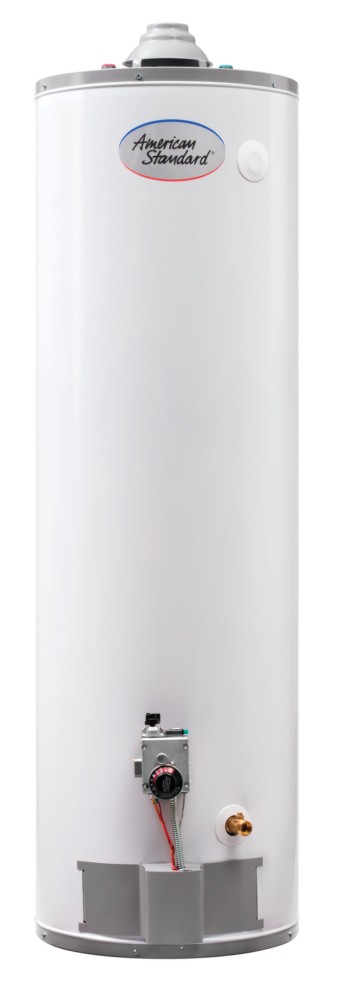
American Standard Water Heaters offers a tank warranty of up to 12 years on some products,
such as its Low NOx atmospheric unit, which also includes a 6-year warranty on parts.
Watch for Red Flags
For contractors and homeowners, there are some factors to make certain the warranty remains intact. The first step is to register the product with the manufacturer.
“One of the things we’ve done with American Standard Water Heaters is establish an online tool that makes it easier,’’ Alpert said. “We have a new tool designed to give customers the ability to check the warranty. Distributors can even send in warranty information digitally. Online registration with warranties eliminates the challenges that come with handwriting on forms.”
Rohde said most warranties are standard with minor nuances in language. Still, contractors and homeowners should pay attention to details. “For the most part the language is identical,’’ he said. “But there are some exclusions and modifications. It’s important to read the language, and in some cases, the warranty might be limited to the original owner. There may be some language around maintenance. The warranty is something that people need to pay attention to.
Thomas Renner writes on building, construction and other trade industry topics for publications throughout the United States.

Housing projects are complex enough, these stylish products can streamline the furnishing process Multifamily housing projects can get expensive but knowing what fixtures to use may reduce overhead costs and help contractors simplify the furnishing process in the kitchen and bath. From sleek modern fixtures with clean lines to timeless traditional styles that exude classic Read more
Housing projects are complex enough, these stylish products can streamline the furnishing process
Multifamily housing projects can get expensive but knowing what fixtures to use may reduce overhead costs and help contractors simplify the furnishing process in the kitchen and bath. From sleek modern fixtures with clean lines to timeless traditional styles that exude classic charm, Peerless® Faucet provides contractors multifunctional options to complement any kitchen or bathroom renovation. The brand’s designs also feature quality materials, bold finishes, and user-friendly functionality, ensuring every fixture combines beauty and practicality.
Beautiful Designs for Every Style
Peerless fixtures are celebrated for their stylish aesthetics, which range from modern minimalism, contemporary, and even timeless traditional styles. Whether it’s a sleek chrome finish for a contemporary kitchen or a brushed nickel fixture for a cozy bathroom, the brand offers contractors a wide variety of options to complement any unit’s look and feel.
By focusing on clean lines and thoughtful design elements, Peerless creates faucets and fixtures that do more than just function — they elevate spaces, making them visually striking. This appeal is not only popular among contractors aiming to bring on-trend looks to their multifamily projects, but also renters who are looking to upgrade their fixtures without the hefty price tag.
This year, Peerless launched its new Ezra™ Kitchen and Bath Collections — with an array of unique finish options to choose from. In the kitchen, the Ezra Single-Handle Pull-down Kitchen Faucet offers striking lines paired with soft, sweeping curves. This faucet completes a traditionally modern aesthetic that pairs nicely with chestnut brown cabinetry and black/silver finishes alike. In fact, introducing the current mixed metals design trend into the kitchen is easy with Ezra. One can accessorize around the faucet with soap dispensers, cabinetry handles, lifestyle pieces or even other appliances — pairing the finish with a contrasting metal.
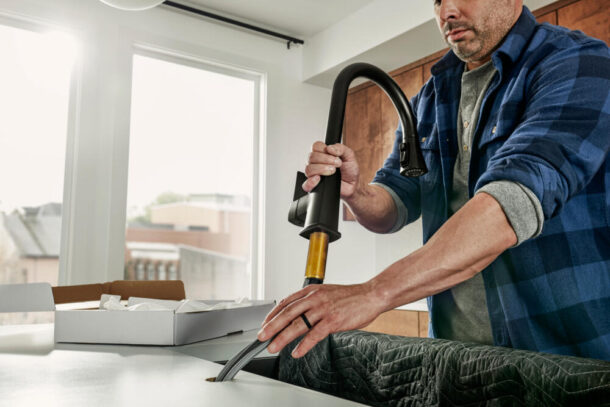
The EZRA™ Single-Handle Pull-down Kitchen Faucet (Matte Black)
Quality Materials Without the Big Spend
A successful commercial build starts with strong foundations, and to ensure projects provide long-lasting renovations, contractors should prioritize durable, high-quality materials are present across their kitchen and bath fixtures.
Peerless is renowned for its commitment to quality, crafting fixtures from durable materials (i.e. ceramics within most faucet disk valves) designed to withstand the demands of daily use. The brand’s faucets are built with long-lasting finishes that resist tarnishing and corrosion, ensuring they maintain aesthetic appeal for years. For contractors working on multifamily projects, Peerless offers ceramic valves across many fixtures, so no matter what collection contractors choose, they’re always guaranteed quality and durability.
Functional Affordability Without Compromise
One of Peerless standout qualities is its affordability. Renters on a budget and professionals managing large-scale renovations alike benefit from the brand’s cost-effective, yet functional offerings.
Beyond its stylish, on-trend designs, the brand also offers fixtures that are equipped with useful functionalities that contractors should be aware of. Peerless strives to ensure it provides additional value to the end user, by offering affordable, smart solutions in the kitchen and bath:
- POWERinse™: When money is tight, this technology is a great option to save contractors and renters additional spend on sink washing alternatives. More than a typical spray mode, Peerless’ POWERinse™ utilizes extremely narrow ports to create back pressure. That back pressure, in turn, results in a blast of water that easily powers away food residue.
- Push Pop-Up Drain Assembly: Included in a wide range of Peerless bath fixtures, this complimentary feature saves contractors both time and money while delivering on-trend details. Unlike other drain assemblies that require multiple parts (and purchases), this user-friendly accessory works seamlessly with the faucet itself and comes with all necessary parts for easy installation.
- MultiChoice® Universal Valve: This nifty valve gives contractors the freedom to decide on what type of shower valve function and trim style they want — without altering the plumbing behind walls. It also works with an array of shower trim styles. MultiChoice Universal Valve also pairs with shower trims across the Delta Faucet Company portfolio, making redesigning a breeze.
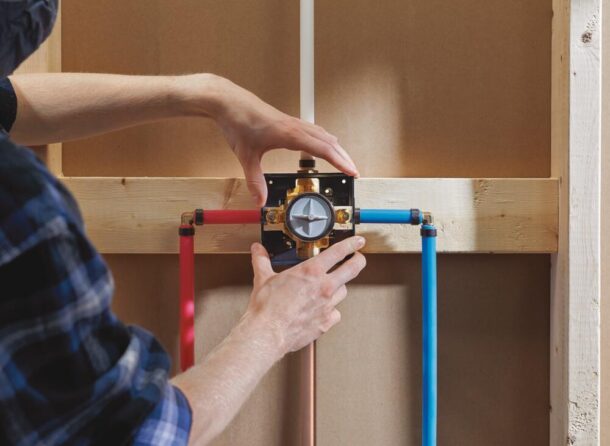
MultiChoice® Universal Valve
Peerless understands that no two customers are the same. Contractors value its dependability and efficiency, while homeowners love the brand’s ability to transform their kitchens and bathrooms affordably. In today’s world, where functionality and design must coexist seamlessly, Peerless stands out as a brand that delivers on all fronts. Whether you’re a seasoned contractor or learning the ropes, Peerless keeps trade pros happy by offering fixtures that are stylish, durable, easy to install and affordable, proving that elegance and affordability can indeed go hand in hand.
For more information about Peerless and its multifamily offerings, visit www.peerlessfaucet.com/faucet-professionals or follow Peerless on Instagram, Facebook, or Pinterest.
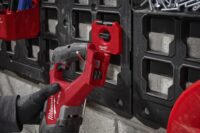
If you’re a plumber, then you know how crucial it is to have the right tool on hand when you need it. The most effective way to ensure this is to turn your work vehicle into a mobile workshop, essentially carrying every tool, supply, and spare part you may need for all the types of Read more
If you’re a plumber, then you know how crucial it is to have the right tool on hand when you need it. The most effective way to ensure this is to turn your work vehicle into a mobile workshop, essentially carrying every tool, supply, and spare part you may need for all the types of jobs you regularly do.
Ensuring that your plumbing vehicle is equipped with the right equipment will ensure that you’re not only organized but ready to respond to a call out at a moment’s notice. We take a closer look at a few features you’ll need to create an effective mobile workshop.
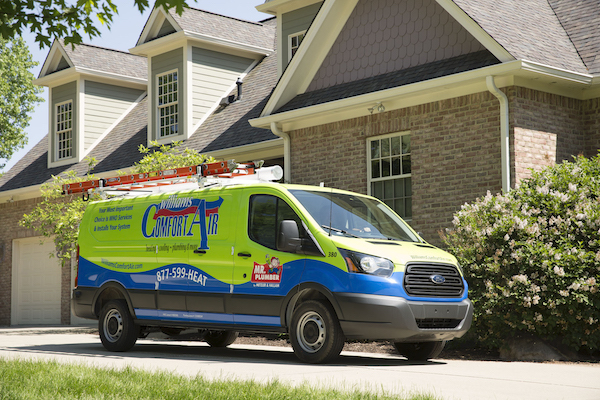
Get Insured
Getting your plumbing vehicle insured is the first step in having a competitive edge over other plumbers. Before you even start setting up your mobile workshop, it’s essential to have the right mechanical breakdown insurance in the event of vehicle failure en route to a job.
A quick look and understanding of what is mechanical breakdown insurance will highlight that this type of coverage extends to everything from accidents to engine failures. It’s essential to choose the option best suited to your specific professional needs.
Add a Partition
If your plumbing vehicle doesn’t already have a partition that separates the diver’s cabin from the workspace, it’s essential to add one. This ensures anyone in the front of the vehicle isn’t injured by loose tools that may slide forward. Mesh screen partitions are an option to consider if you want to keep an eye on the back of the vehicle while driving.
Install Shelving
Shelving is essential for organizing your plumbing vehicle and an effective way to create as much storage space as possible. Since shelving can be customized to fit a range of different shapes and sizes, you’ll easily find the best shelves that suit your vehicle’s dimensions.
Adjustable shelves or folding options are also a good idea if you’re limited in space. Check for shelves that can accommodate hooks for any smaller items that may get lost if they’re not secured.
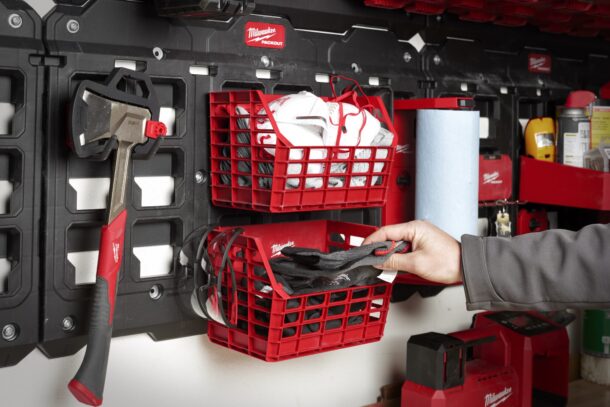
Include Floor Mats
While some may regard floor mats as unnecessary in a work van, adding a mat in the section where you work, or store components will reduce the dirt and debris accumulating there. They not only provide a non-slip surface to work but also reduce the cleaning needed and prevent damage to the floor. Rubber options are a good choice here.
Add Cabinets and Bins
A cabinet is an effective way to store all the smaller, loose tools that you may need, such as TwinGrip pliers and screwdrivers. Bins are ideal for storing small plumbing components and spare parts needed for basic repairs and replacements. Having the parts on hand means there are no unnecessary delays because you need to leave the job to find the necessary components.
Use the shelves, bins, and cabinets to organize the tools you use most frequently. The more organized you are, the easier and quicker the job can get done. If you have an assistant who also uses the tools, consider labeling the drawers and cabinets to ensure that everything stays organized.
Some examples may include “cleaning supplies” or “repairing tools”. It’s also a good idea to add latches to all the drawers and doors on your cabinets, as this will keep them from sliding open.
Opt for a Van Rack
Depending on the type of plumber you are and the types of jobs you do, the interior of your vehicle may not be big enough for ladders and longer components. The top of your vehicle may be better suited for securing ladders and long pipes. To achieve this, consider adding a van rack or conduit carrier to keep items secure.
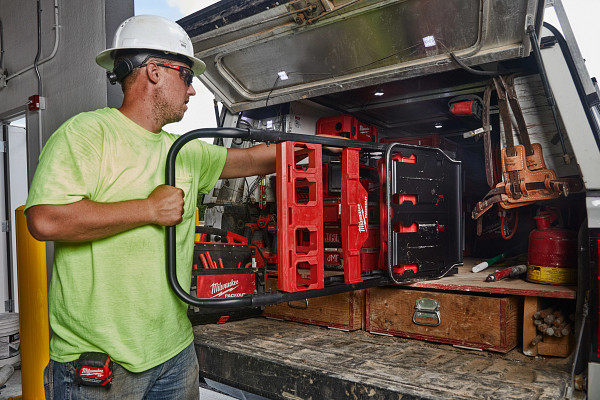
Consider Ready-to-Fit Van Packages
If you’re not sure how you’re going to fit everything into your vehicle, consider opting for a van package. These are shelving solutions specially designed for storing plumbing equipment in the back of a van. Typically, these packages consist of the following:
- Partition
- Shelving
- Cabinets
- Storage hooks
While these packages are a good idea, they may contain aspects that you don’t need or it may be a struggle to get them to fit if you have other shelves already in the vehicle. You may need to check with more than one supplier for the option that works most effectively for your vehicle dimensions.
Wrapping Up
Whether you work for a contracting company or you have your own plumbing business, having a fully stocked plumbing vehicle is crucial. You will not only look more professional and reliable but will also get the job done quickly because you have what you need available when you need it. In a profession where time is money, this makes the most economic sense.
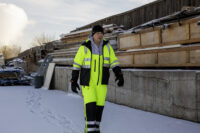
RefrigiWear, a 70-year pioneer in safety apparel and insulated PPE for winter workers, now delivers two high-visibility versions of its best-selling insulated softshell bib overalls. Available in high-visibility lime or high-visibility orange, the HiVis Insulated Softshell Bib Overalls are perfect for plumbers, pipefitters, tower climbers and road construction workers who need to stay warm and Read more
RefrigiWear, a 70-year pioneer in safety apparel and insulated PPE for winter workers, now delivers two high-visibility versions of its best-selling insulated softshell bib overalls.
Available in high-visibility lime or high-visibility orange, the HiVis Insulated Softshell Bib Overalls are perfect for plumbers, pipefitters, tower climbers and road construction workers who need to stay warm and visbile in cold, wet weather.
Ready for Rough Weather
HiVis Insulated Softshell Bib Overalls from RefrigiWear give workers the protection they need to get the toughest jobs done, even in temperatures as cold as -20°F. With a wind-tight and water-repellent outershell to guard against rain, sleet, snow and icy winds, these bibs help workers stay warm, dry and focused on the job.
Working through rough weather requires outerwear tough enough to take on the cold without falling apart. Abrasion-resistant patches and reinforcements help these insulated overalls stand up to tough work, especially when the job requires kneeling, squatting or climbing. Two rows of durable silver reflective tape are bonded, not stitched, on the legs to avoid snagging on equipment or unraveling with long use.
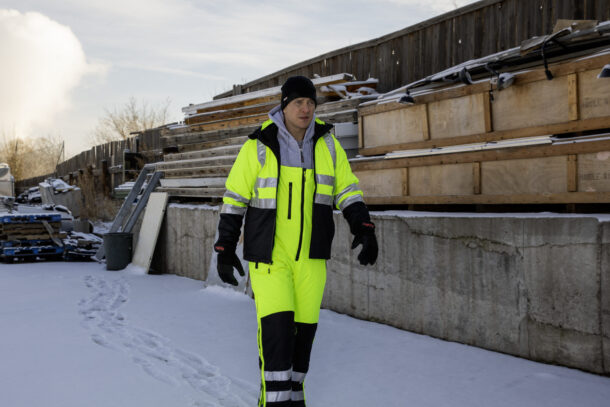
Warm, Comfortable & Functional
When the wind chill falls below freezing, most folks would rather head for home. For those who must stay and face the freeze, HiVis Insulated Softshell Bib Overalls deliver over 400 grams of lightweight, synthetic insulation. Plus, a silver heat-reflecting lining traps escaping body heat and reflects it back to the wearer for extra warmth and comfort.
Adjustable Y-back suspenders provide higher coverage for the back and torso. This design protects the vulnerable organs in the core from the cold without limiting range of motion in the shoulders, so workers can swing hammers, lift lumber or simply stretch their arms in complete comfort. Above-knee leg zippers make it quick and easy to step in or out of these overalls, so there’s no need to waste time removing boots when workers need to warm up or cool down quickly.
Safety Standards for Visibility
The high-visibility outershell materials and reflective silver tape on these bibs meet American and Canadian standards for safety on hazardous job sites. Both the high-visibility lime and high-visibility orange styles meet ANSI/ISA 107-2020 Class E and CSA Z96 Class 2, Level 2 standards.
Available in Extended Men’s Sizes
Available in extended men’s sizes from small to 5XL, HiVis Insulated Softshell Bib Overalls protect workers from cold, wet and windy conditions without compromising warmth, visibility or range of motion.
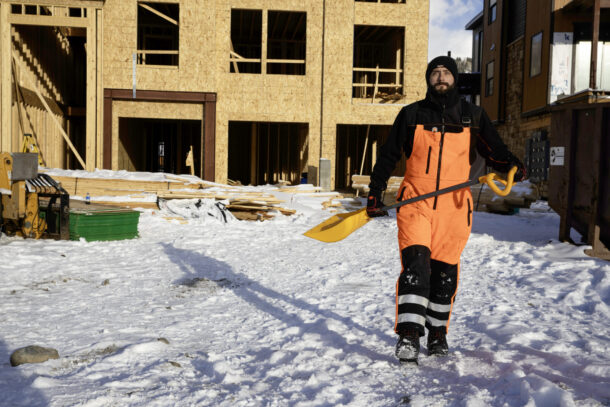
Complete Protection from Cold, Wet Winter Weather
When temperatures are freezing and falling fast, the secret to staying safe on the job is staying warm and staying visible. HiVis Insulated Softshell Bib Overalls coordinate perfectly with other garments, gloves and waterproof work boots from RefrigiWear, including the HiVis Insulated Softshell Jacket and several insulated hoodies and thermal sweatshirts in high-visibility colors.
Learn more about outfitting your team with weather-ready, high-visibility outerwear at pro.refrigiwear.com.
